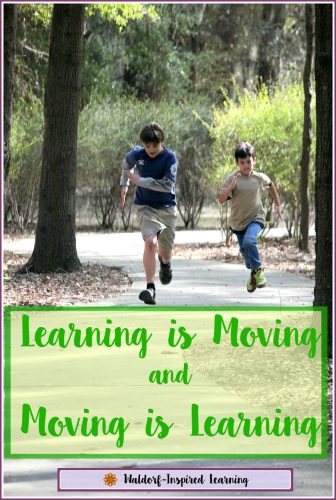
This is a guest post by Janet Allison of Boys Alive! I recently connected with Janet after hearing her on the podcast at A Waldorf Journey. She’s an expert on boys. So am I, in a way, since I’ve raised two boys! My best advice on parenting boys: “Talk Less. Move More.” Because moving is learning.
And Janet has the research to back that up! I love listening to her talk about how boys’ brains are different than girls’. In this post, Janet gives the whys and hows of moving and learning, so we can weave more movement into our homeschooling days. If you have boys (or know any boys 🙂 ), this post is for you!
Learning is Moving and Moving is Learning
In terms of our brains – we are not that far removed from our ancestors.
But how does this affect daily life with your boy?
Scientists say that our hunting ancestors traveled about 12 miles every day. That’s a lot of territory! You may feel like your son is traveling about that many miles over your couch and around your house!
Take that ‘hard-wired’ need to move and just try to make him sit still in a hard chair for even just one hour a day!
Those hunters were moving – and while they were moving, they were handling their weapons and tools, creating new ones, repairing old ones, and interacting with their environment in a very tactile way.
Take that need to touch everything and just try telling him to keep his hands to himself and not to play with the paints and water jar!
When we stop him – from moving, from using his hands to explore his world – we deny his built-in programming and we create a disconnect with the very deep inherent nature of our boys.
And he feels it.
He is designed to move and to touch – when he does, his brain lights up saying, “Hey, learning is happening here! Pay attention! This is important!”
Another essential feature of the male brain is THE REST STATE.
As a hunter, he was 2000% engaged in hunting, killing, skinning, cutting, and bringing food back to his tribe. This effort took an enormous amount of calories, muscle power – and brain power.
When he’d delivered the food, his brain had to shut down in order to refresh. His brain went into a rest state – and it still does.
Have you observed this happening in your son or your husband or your father?
He sits down and zones out – so easily! He sleeps all night without a care – while your busy female brain is awake at 3 a.m., writing lists in your head. His brain is designed to rest.
Take that rest state and put it into 2016 and you’ve got issues.
Many boys intuitively recognize that by moving something, his brain stays out of a rest state. Tapping a pencil, swinging a leg, bugging his sibling, fiddling with paperclips or rubber bands – all keep his brain out of the rest state and paying attention to you!
Can see how a boy may be headed towards frustration and failure if the adults in his world don’t understand these innate features of a boy and his brain? (You may also recognize that some girls have these features, too.)

Here are 7 ways to make your homeschool more boy-friendly:
#1, #2, and #3 is MOVE!
Make sure he has an opportunity to be physical before lessons: take a walk/run, ride bikes, jump rope or play basketball. Taking 15-20 minutes before lesson time will make a huge difference in his ability to listen and learn. (And what is good for boys is also good for girls!)
#4 Alternative seating: Adjust expectations and seating selections.
Exercise balls, stand-up desks (which can be as simple as a box on a table top), standing, pacing, reclining with work on a clipboard – all of these alternatives help boys keep their brains out of the rest state, and give them an outlet for their busy bodies. Allowing children to have a squeeze ball is a great alternative when he does have to sit at a desk or table.
#5 Hands on everything!
A middle school science teacher told me how challenging it was to get her students to listen to the lecture part of an experiment. They were focused only on the equipment and she spent precious teaching time managing their behavior…until she learned to “Ride the horse in the direction it is already going.” They wanted to touch the equipment, so when she gave them time to explore it BEFORE she began her explanation, all of the students were better able to listen and focus on the task at hand.
#6 Move again!
When any human being has been sitting for about 10-20 minutes, we begin to lose focus, while our blood settles down into our bottoms. Nourish the brain, increase focus and concentration, and breathe again just by taking a 1-2 minute “brain break.” It can be as simple as, “Do 5 jumping jacks, touch your toes, and get a drink of water.” Everyone will be revitalized, ready to focus – and, besides, it’s fun!
# 7 – Silence!
We all need ‘down time’ to process our day. Boys especially have had to ‘hold it together’ in a very verbal world. Our hunting ancestors didn’t talk all that much and the male brain developed with fewer places to process verbal input. In short, he’s exhausted by the end of a school day. Give him some quiet, unstructured, (NON-media) time so he can digest his day.
Whenever you find yourself frustrated with your boy – choose movement.
Get up and have a dance party, run around the block, or do some jumping jacks.
Without fail, he will be ready to reengage – and you will be, too!
Janet Allison is an author, educator, family coach, and Founder of Boys Alive! She has helped thousands of parents and teachers understand their boys. She is the host of the BOY TALK podcast and a thriving Facebook group. Learn more at http://www.boysalive.com




2 Comments